By Brian Schulz
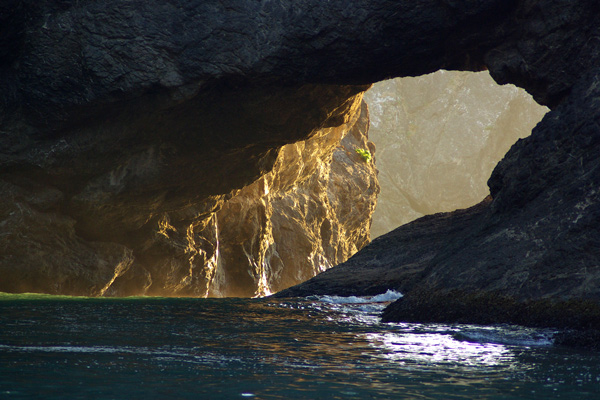
At dawn Mike and I crossed the bar in Bandon, picking our way through breaking waves into a wet morning fog. Peripherally I tracked his line past thundering surf and the boiling surge that slid up and down the faces of the rocks. His path was less conservative than mine, but not in the least bit a path that tempted fate. There was no tension or adrenaline in his approach, simply a fence of certainty that comes long experience on open coastlines, the ability to see an invisible line in the water that separates safety from being dashed to splinters. Heading southward and blown along by a stiff wind, we chatted amidst eight foot white-capped seas, interrupting conversion only momentarily while one of us snapped a quick rudder or draw stroke to prevent a collision. The crossing from Bandon to Cape Blanco was twenty miles and took five hours so it was nice to have someone to talk to. The Cape buffered a thick blanket of fog and mist and we threaded a field of spikes and domes in moderate swell and heavy chop under a low sky. Using the pulsing surges, Mike followed instinctive paths through the swift channels, and I followed him. Mike knew his stuff and it was a pleasure to paddle with someone who chose such good lines.
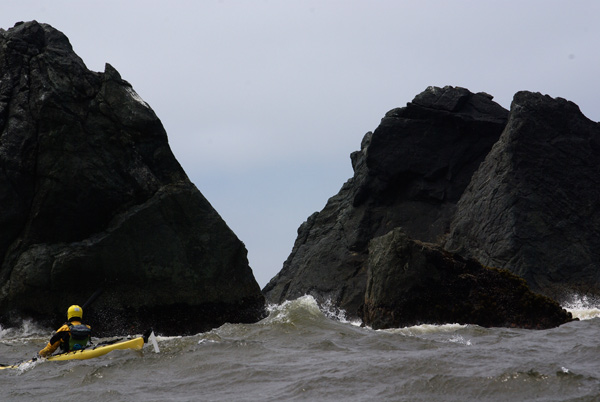
By four-o-clock in the afternoon I was having second thoughts. Walled in on a tiny driftwood-choked beach on the south side of Cape Blanco we were safe from the surf and the wind, and there was a marginal slope to escape from the rising tide if need be. A pair of peregrine falcons screeched and circled overhead below a ceiling of mist that ripped off the top of the bold escarpment that surrounded us. I'd seen what those wicked little raptors could do and was glad that evolution had kept them small. My concern here wasn't the birds though, it was Mike. This serious lapse in judgment brought into sharp question the rest of his decisions and I wondered how far my trust really extended. I narrowed my eyes skeptically as he handed me the plastic cup and I sipped. "So, how do you like it?" he asked. "Wretched." I spat, "What is this stuff?" "It's one-fifty-one and a two year old packet of cheap Mexican Tang." He answered matter-of-factly as though there were nothing unusual about handing a buddy a cup of poison liquid. My eyes bulged and cracking open my own beer, in a bottle, I lectured, "The point of cocktail isn't just to catch a buzz, the point is flavor. The flavor should saturate the palate and the buzz is merely a vehicle to enhance the experience of the flavor." Mike stared at me, wondering who he had become trapped on this tiny beach with. I continued a few minutes later. "The point is to know what is good in life. For instance, I purchased every available brand of macaroni and cheese for this trip," I explained while I levered my tiny aluminum pot into our roaring driftwood fire on the end of a ten foot stick. "...and with each day I will prepare and evaluate them empirically, thus determining once and for all which brand is the cheesiest." Now it was Mikes' turn to regard me skeptically, and also to point out that black smoke was rising from my pot. I withdrew the smoldering pot and plunged my fork into a rubbery mass of hard brown noodles. "So how is it?" Mike asked, grinning. "Chewy, smoky, and difficult to swallow." I replied, "There are obviously quality control issues at the factory, I wouldn't recommend this brand."
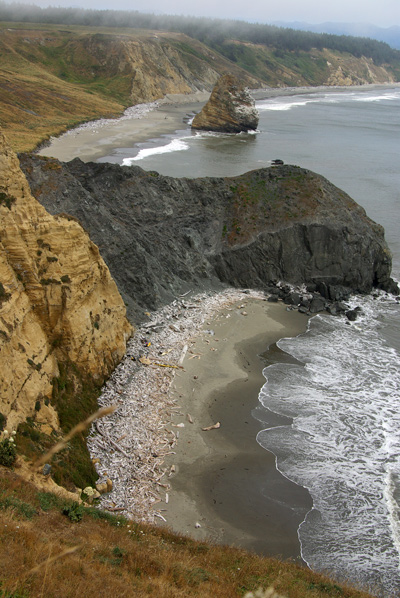
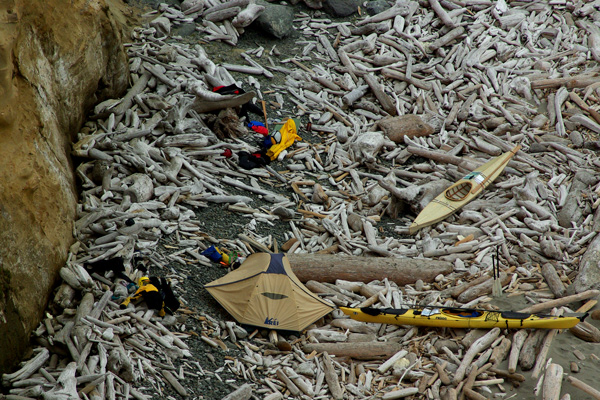
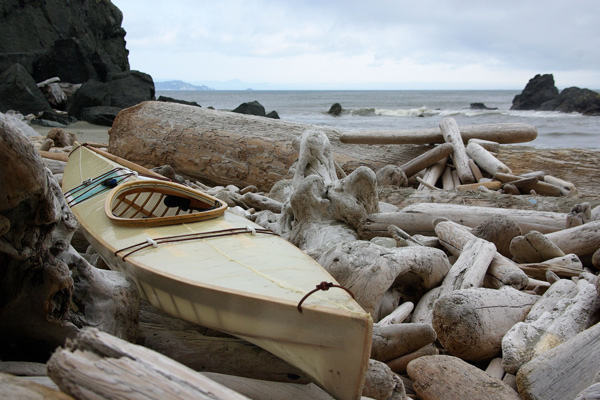
Mike Higgins looks more like a mad scientist than a hard-core sea kayaker. A mat of swirling hair twists away from his scalp, intelligent eyes peer from behind tiny circular glasses, His face is just beginning to show the creases that come with age, laughter, and a continuous exposure to salt spray. A full goatee adds gravity and the sense that he might begin a dissertation on quantum mechanics at any moment. A software engineer from Sonoma County, California, Mike has a reputation for brilliantly unorthodox solutions that ensure employment on his own terms, terms that usually involve a lot of time off to go kayaking. Mike isn't bulging with muscles and he seems to have a notable lack of enthusiasm for surf and rock gardens, which is odd to me, considering that this is exactly the type of paddling he pursues.
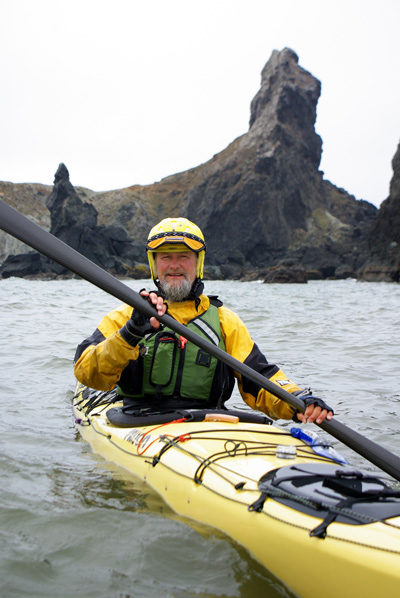
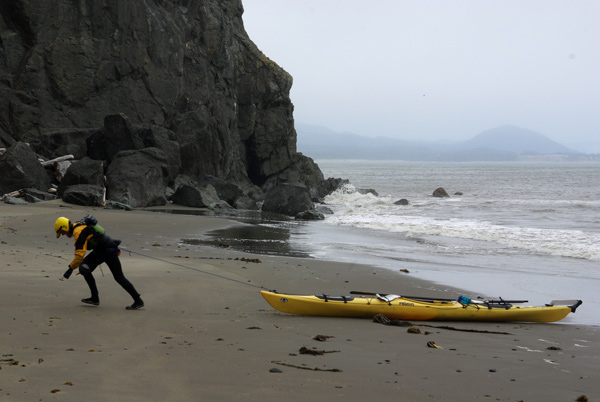
Ensconced behind the towering sandstone rampart of Cape Blanco, I spent the afternoon exploring nooks in the rocks, and scoping out a gorgeous wave in the adjacent cove that begged to be surfed, and I would have had it not ended in an evil looking line of rocks. Mike and I scrambled up a narrow tongue of scree on the slope behind the camp to the top of the cape where a glorious old lighthouse stood testament to a time of brave sailors and frequent shipwrecks. This lighthouse originally contained a Fresnel lens, a conglomeration of hand carved prisms set in brass to form an enormous gleaming gem capable of magnifying a lit gas lamp into a powerful beacon. Slowly revolving overhead the current lens was more ordinary, carved glass with an electric light, but still it sparkled warmly against the misty grey sky. We considered sliding open a window and crawling in to get a closer look at the thing but decided the authorities might view our transgression as more than a prank. Sliding back down to camp on the sharp talus slope I joked, "You realize this is the most dangerous part of kayaking right?" The following morning we slid back into the safety of our kayaks and paddled away from the hazards of terrestrial exploration.
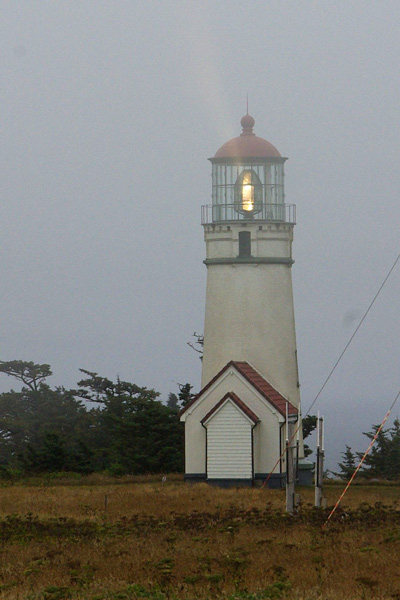
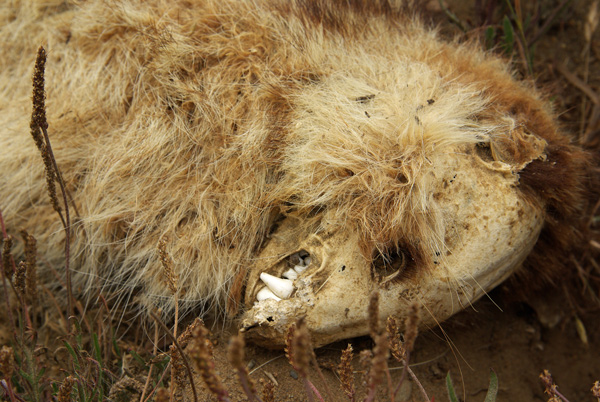
Our hundred-mile trip south from Bandon to Brookings was more than just another week of pretty rocks and secluded beaches, it was a celebration. These miles were the last ones in Mikes' quest to see the West Coast of the United States. What began innocently as a few small sections of northern California became a curiosity of what lay between them, then a few paddling trips north and south, and then a desire to link them to the others. Unlike myself, who famously hitchhiked with my kayak past sixty miles of sand dunes, Mike has planted his paddle in every last bit of water between Neah Bay and Tijuana, unafraid even of the endlessly dreary beaches of southern Washington. I was happy to join Mike for this section though, not only was it the last, but also the best. Southern Oregon waters are a maze of spires and caves, a paradise of thin slots, arches and channels, or a churning cauldron of danger, depending on the conditions. Mike and I agreed that it is the required skill set that keeps this place remote and largely unpaddled. A lucky kayaker might find a day or two of calm water here but those days are the exception rather than the rule. Most people simply aren't willing to face the prospect of being ground into bite sized chunks against the barnacle encrusted cliffs.
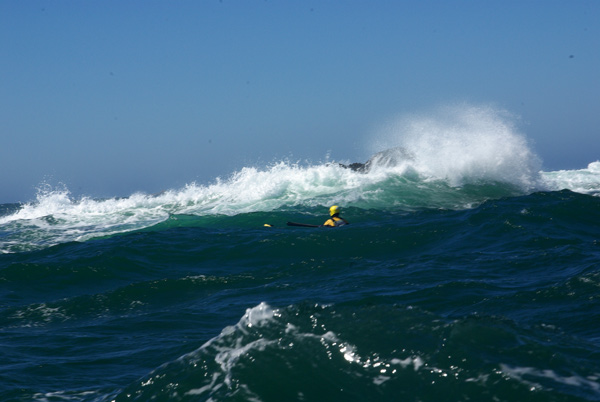
South of Cape Blanco Mike and I were just getting into the good stuff, we detoured five miles offshore to explore a collection of large rocks we jokingly dubbed "the land of mystery", knowing full well that it would be just like every other batch of offshore rocks, sea lions, kelp, and an arch we probably couldn't paddle through. Something about paddling toward a cluster of distant rocks in the mist inspires a feeling of childlike adventure though, and maybe that feeling was more important what we actually found out there. We played it safe and tried not to bother the enormous stellar sea lions that roared at our presence from the rocks above. Larger, louder, and with bigger teeth, those things made African lions look like kittens. While Mike seemed unconcerned I shored up my pride by saying that it was perfectly OK to be afraid of a two thousand pound menacing sea monster with four-inch long incisors. Uneaten, we headed southeast in a rising wind and toward what would become one of the more serious kayaking emergencies of my life.
I announced my needs halfway back to the mainland. Mike lingered while I popped my skirt and tugged at the relief zipper on my dry suit only to find it stuck firmly closed. 'No problem', I thought, I'll just pull a bit harder... but nothing. I tugged a few more times with no result. "No." I whispered, looking down in disbelief. The horror of my predicament hit me like a steamboat, I'd consumed quart of coffee for breakfast and I hadn't given a second thought to the desperate building pressure, until now. There was no chance of making it to land, and I'd explode before I'd pee in a new gore-tex dry suit. My bladder would swell until it blocked the blood flow to my brain and then I'd tip over and drown. "s*#!" I yelled, bobbing helplessly in the rising chop as I pulled madly at the frozen zipper. "f---, f---, f---!" I screamed, amazed that in only a few short minutes I'd gone from peaceful paddler to gale force temper tantrum. Minutes passed as I yanked and cursed, and I made the decision to pull as hard as I physically could, risking destroying the zipper. Once, twice, and then the teeth burst open, revealing my still dry fleece liner, the zipper thankfully undamaged. After the business was attended to, I poured sunscreen over the teeth and zipped it open and shut ten times, vowing to never again to take for granted this most important portal.
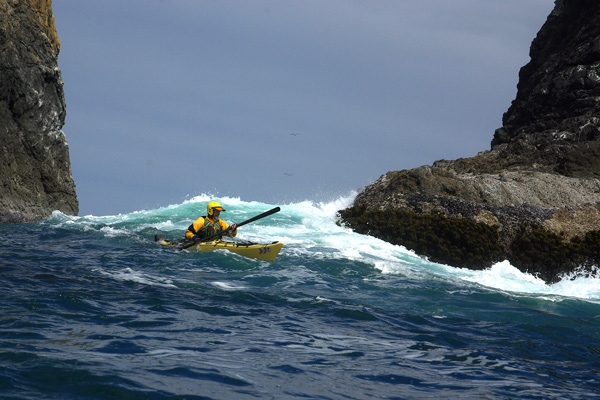
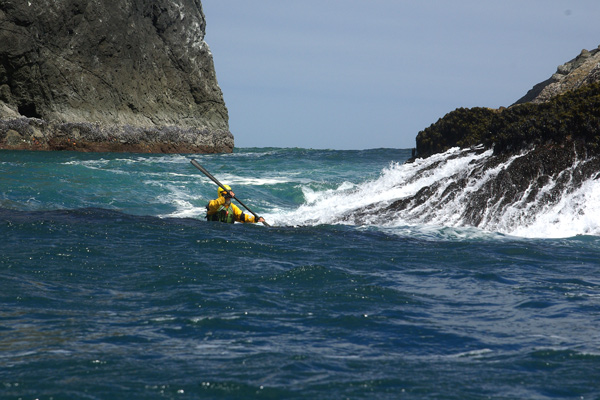
Port Orford is a defined hook, a tall basalt headland that extends southwest into the Pacific. Not just one head, but several guard one of the only natural rough water refuges on the Oregon coast. We arrived at noon and crossed the front of the head in thrilling surge, beautiful teal water rising ten feet up sea palm and mussel encrusted slopes only to pull back in a cascading torrent of froth. Mike and I flirted with the whitewater before rounding the corner into a series of peaceful bights, calm water and kelp beds, full of fun rocky channels to explore. The second cove back held the remains of an early lifeboat station where the precursor of our modern Coast Guard, the United States Lifeboat Service launched under oars to save the lives of sailors on stranded ships. The concrete pillars for the long since disintegrated wooden launch ramp stepped into the water, and interestingly, a series of small islands had been connected with high concrete walls to provide even more protection for the natural cove. The idea of rowing, in oilskins, into thirty foot breaking winter surf horrified me, but these men did it, and surprisingly, most of the time they survived. I think of how these men would laugh at the worst of my stories, "that's not a story boy," I imagine them saying, "let me tell you about the time..."
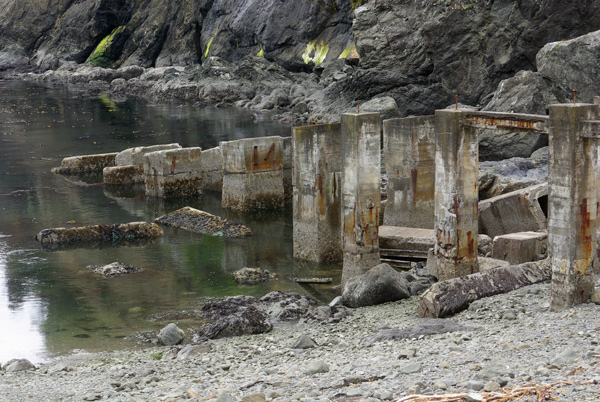
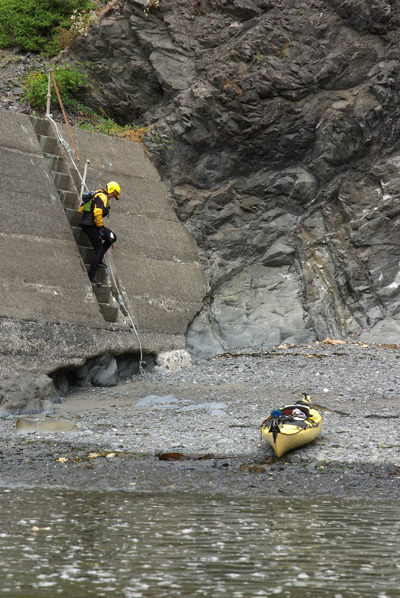
Feeling humble, we paddled on toward another smaller hook behind point Franco. With a bit of wind on the water I chose to fly the kite and Mike eyed my setup carefully. The specially designed kayaking parafoil was connected to two hundred pound line that led down a hundred feet through a carabiner on an adjustable line to the bow, and back to a winder tucked under the hard leather deck lines of my skin-on-frame kayak. I was connected to both the winder and the kayak via my tow belt. A sheathed knife was tucked next to the winder and I checked its position every few minutes. Mike was impressed by the ease at which I glided alongside him in the six foot breaking seas. I explained the risks to him, "Basically you need to be comfortable with the idea things will eventually go horribly wrong and you will end up upside down and tangled up in the thing. You might be underwater for a long time while you cut yourself free, and if it's dragging you upside down, your only hope is to roll up with a reverse sweep Eskimo roll. Deploying it is like trying to weave a basket while kayaking through class three rapids without a paddle. Make no mistake, you can kill yourself."
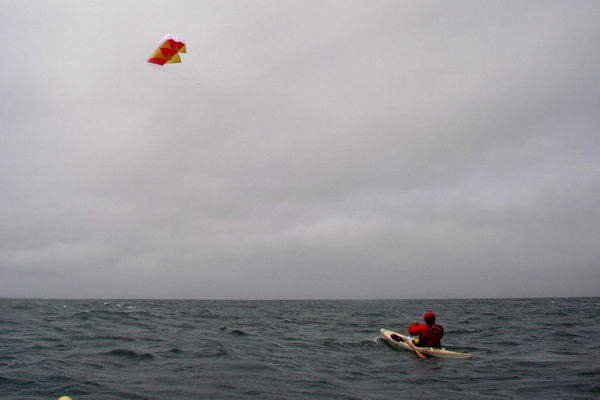
I pulled the kite down at the first sight of white streaks on the water, indicating that the wind had jumped past 25 knots, and making flying dangerous, or perhaps I should say, more dangerous. We paddled toward a slot between a large offshore rock/island and two rounded lumps connected to the mainland that I dare speculate were named 'the Sisters' due to their bosom-like shape and symmetry. We were close to shore now where the water was green from the turbulence of the surf. The forty-foot wide channel was a riot of ten-foot refracting waves. The question in these situations is always the same, 'what am I not seeing?' It's not enough to presume a bouncy slot in safe, you need to be certain that there are no exposed rocks, dangerous cross currents, and most importantly that you are not paddling yourself into a rocky sieve. At the top of every wave our eyes strained in all directions before plunging back into the trough, and when we were convinced of safe passage we paddled into the boisterous but otherwise harmless passage, grinning like fools and letting the waves shove us around.
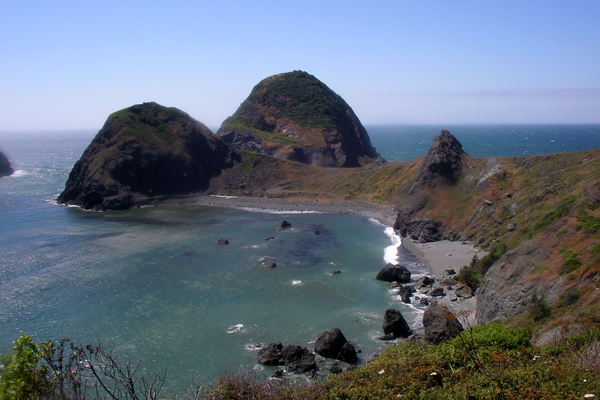
Rounding the corner we discovered that what appeared to be a hook on the map was actually an isthmus connecting the sisters to the mainland, essentially a wind tunnel through which the now near-gale onshore wind was blasting over a sandy beach strewn with large rocks, and bits of industrial junk. Mike shares my hatred of sand so we pasted our camp against a south facing rock just barely escaping the blowing grit. Convinced that there must be a better spot 'just around the corner' I led Mike up one of the crumbling mounds, "just a little farther," I goaded as we fought our way through brambles and fields of poison oak, only to arrive at the top unable to discern whether or not there was a better spot to the south. "I'm never following you anywhere ever again." Mike grumbled.
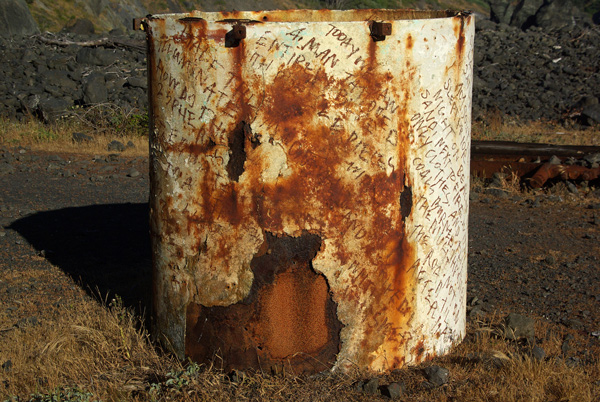
By nightfall the wind had died to a mere twenty knots and I roamed the shore exploring the junk, I have a penchant for abandoned industrial stuff, so for me this was as good as tide pooling. The lack of driftwood on our beach preempted my normal pyromaniacal activities and I had to be content with only a large fire. Somewhere I'd read you could cook with salt water so tonight my macaroni rested in the coals in a bath of brine. "How is it this time?" Mike asked noting the twisted expression on my face. "Terrible!" I replied, "Almost inedibly salty, I wouldn't recommend this brand either."
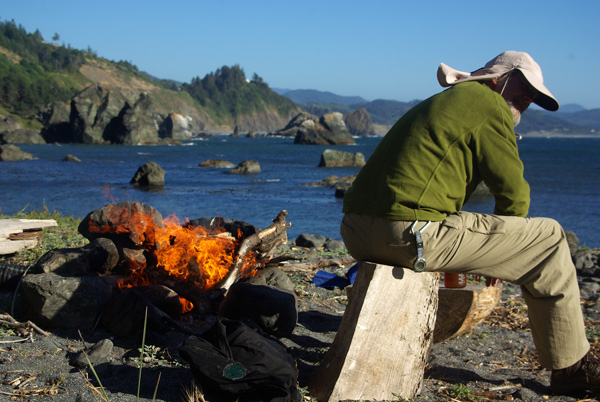
The next morning I awoke in my sleeping bag to note a key difference from every other day I'd awoken on the Oregon Coast. I wasn't soaked in dew, and the skies were blue and not grey. I also noticed that the plants in the brush behind me were different as well, pines instead of spruces, poison oak instead of salal. 'This is pretty cool.' I thought noting the abrupt change of climate zone. Before launching I dragged a paraffin candle along the length of both zippers, a ritual I will likely repeat every paddling day for the rest of my life. We paddled south again in a rising wind with gale warnings predicted.
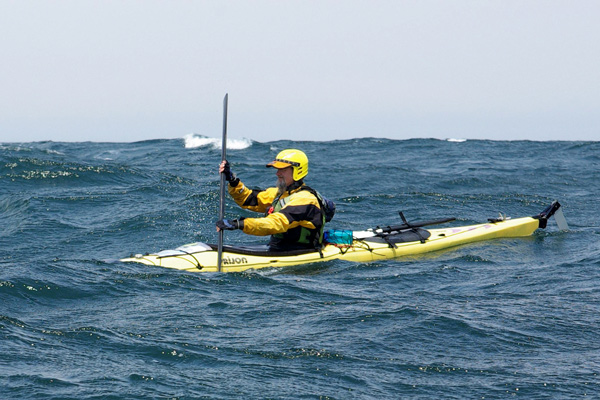
Mike shares my fondness for a Greenland paddles and like me, he learned a long time ago that a Greenland stick gives you just as much push as a spoon blade, but without destroying your shoulders. I paddle with a wooden stick and Mike strokes beside me with a Superior Kayaks carbon fiber paddle, one of the better shapes available, if perhaps a bit overpriced. These futuristic black Greenland blades are the most durable available, although Mike has worn the ends off his paddle and glassed on newer, tougher tips. He paddles in a farmer john, thermal layer and dry top. Less comfortable than a good dry suit, this setup provides the best balance of reliability, freedom of movement, and low cost. Unlike a dry suit, a breach in the system isn't catastrophic. Mike understands that the purpose of immersion gear is to shield the paddler for a few minutes in the event of a wet exit, not a swimsuit for cold water. The daily northwest onshore wind creates upwelling in the ocean here and by mid-summer water temperatures can drop into the forties. The notion of a wet exit in these conditions is literally, a chilling prospect. "I don't care how good your rescues are," I say to Mike, "you'd have to be insane to pop your skirt out here." He nods in agreement, a nod I barely catch as he dips out of sight in a wave trough. While most of our friends are paddling the ubiquitous British-style kayaks, Mike and I are definitely beyond the mainstream. I paddle a skin-on-frame kayak of my own design mostly because I am picky about shape, and because I like paddling a twenty-five pound boat. Mike paddles a Prijon Kodiak and explains his choice from the perspective of someone who can't afford to have things go wrong, "Sure, the shape is pretty uninspired, but the hatches don't leak and the plastic is indestructible. I also like the rudder, it's way more reliable and easy to fix than any jammed skeg box with a frayed out cable."

Waves travel at a speed of three times their frequency divided in half, driving the average six-foot wind wave at about ten miles per hour. Kayaks on the other hand tend to poop out at about six miles per hour, leading to one of the most frustrating discrepancies in coastal kayaking. Rushing downwind in a howling mixture of waves and spray, one looks back to see a ten foot wall of green water streaked with white and thinks "Man, this is going to be a good surf." Then while digging hard and sprinting forward the wave still passes by, giving the kayak a nice shove sideways adding insult to injury as it marches onward, tantalizingly steep, but just not surfable. It was in this irritating state we found ourselves as we approached Gold Beach, so to tip the scales in our favor we skirted the surf where wind waves combined with swell and shallow reefs to initiate the necessary wave steepness to surf. The danger, of course, was the actual surf, which today thundered toward shore grinding through a field of half submerged rocks that I doubted would yield to an impact with my ribs, collarbone, or face. I wear my helmet, but I also know that it won't do a thing to protect my neck and spine. Safety comes from the choices you make, not the armor you wear.
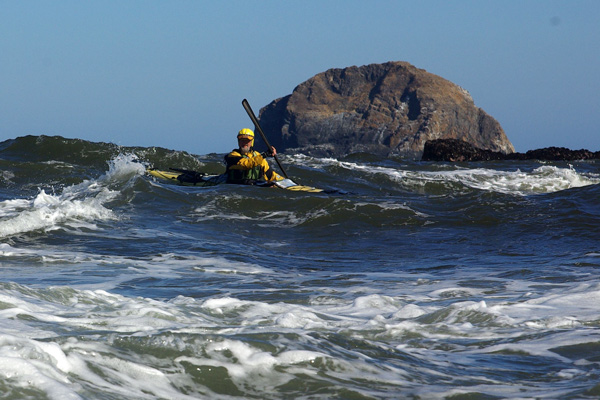
We swooped back and forth on steep careening runs until finally we surfed past the tip of the north jetty and into the mouth of the Rouge River where I'd expected an easy paddle with the incoming tide. Glancing sideways I noticed was that there were no barnacles on the jetty rocks, and then I noticed that I was moving backwards. Due to heavy snowfall this winter, the Rouge was spilling with record flows and there was no tidal flush to speak of, a four-knot current was blasting straight out of the mouth. Making things worse, the wind was wrapping the jetty and blowing in our faces. Brute strength is an often overlooked aspect of the coastal skill set, the ability to grind forward no matter what. We were both tired, we'd been paddling hard for four hours, playing in the waves, and yet we both responded like automatons, skirting edge of the rocks for a slight advantage, and forcing our way upstream for a mile until we reached dock of Jot's resort. "Well that was a bit more work than I expected." I commented, and Mike dripped sweat in agreement.
In Gold Beach we met up with fellow paddler Dave Harry and enjoyed the reward of a civilized meal in a restaurant. Mike ordered a Riesling and I teased him mercilessly about it. Lying in the hotel bed that night and enjoying it immensely I reflected on my life as a kayaker, how I'd once thought that my future lay in long distance expedition paddling, only to discover that I didn't actually like that sort of thing and that a few days in the surf followed by a hot shower and a warm bed was much more to my taste. I thought of how much money I'd wasted traveling to far away places only to realize that I already live where I enjoy paddling the most. It's a strange thing, confronting the difference between who we really are and who we think we are supposed to become.
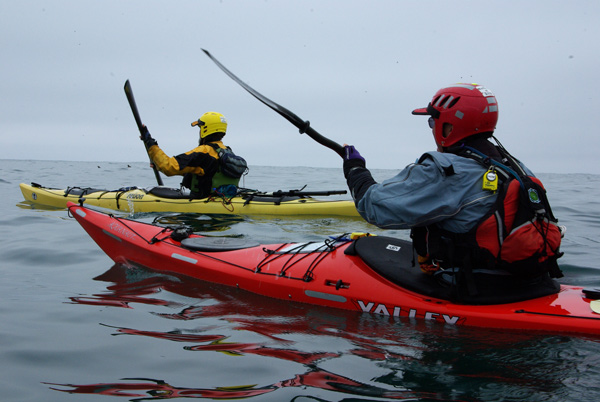
The next morning it was three of us that paddled across the bar, again under clear dry skies. The wind was blowing twenty knots at 9am, and Dave, paddling a red plastic Aquanaut kept looking over his shoulder as today's seas combined with the leftover seas from yesterday dropping him into a harmless, but intimidating ten foot deep wave troughs. Dave has a long history with the sport and I knew better than to be concerned. "Stop pretending to be nervous Dave." I said. "We know it's all an act." Southward we pressed as the winds rose, white streaks appearing on the surface of the brilliantly blue water, the breaking tops surfing us along unexpectedly. Again we approached a line of spikes and domes protecting a south-facing hook of land. A northwest swell and two days of hard blowing wind waves slammed into the reefs while I strained pick a safe channel before the push of the wind committed me against my will. Trying to make a decision I hoped I could live with, I drifted past an exploding boomer that sent a geyser of spray into the wind. I heard Mike yell from behind me, "There she blows!" and I ignored his obvious reference to the boomer I'd narrowly avoided. Again he shouted, "There she blows!", and I turned to tell him to shut up and my field of view filled with an unexpected sight. There were Mike and Dave, framed by exploding reefs and blowing spray, rising up the face of a twelve foot wave, and in the trough between them and I, the back of a huge grey whale rose up and exhaled audibly. Awed and completely immersed in the moment, I turned and committed to my line, paddling relaxed and aware through the churning whitewater on the outside of Crook Point.
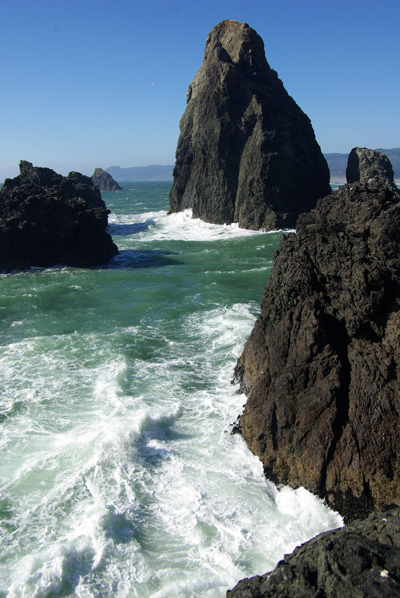
Like the Sisters, we discovered the backside of Crook Point to be a saddle and a wind tunnel, except this time we had to fight like hell to get to shore. It was blowing at least forty through the saddle and we really had bite down to grind out those final hundred yards. Dave announced, "That's about as much fun as I can handle." We followed the standard routine by tucking in tight against south facing cliffs and boulders. I found a perfect spot where a tiny shadow provided relative calm while just twenty yards to my left a torrent of blowing sea spray swept horizontally past between the tip of the point and the offshore island. I pulled out my sleeping bag to insulate from the cold wind and set myself up for a sublime afternoon reading science fiction novels in the brilliant sunlight.
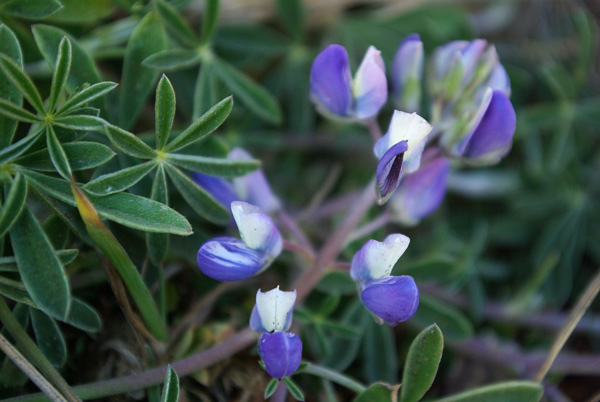
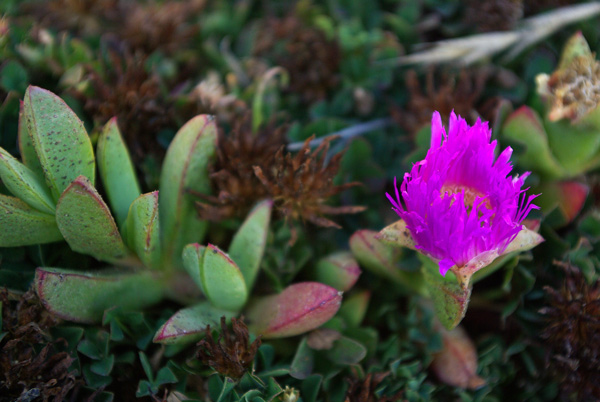
Crook Point is not the most dramatic outcrop on the Oregon coast, not the most precipitous, or even the most riddled with caves and arches. The appeal here is forlorn, raw, and harsh. The effects of ceaseless wind are evident on the crown of the point where the scoured earth reveals nothing but shallow barren gulches of hard tan earth. The dry slopes support dune grass, a few flowers, and small pines sculpted into permanent windblown shapes. The south facing beach is raked clear of all but a few small sticks of driftwood, barely enough to cook a single meal. Climbing through the sharp and crumbling black rocks, I had the haunting sense of exploring a ruined castle, a place so ancient that it could no longer be called majestic.
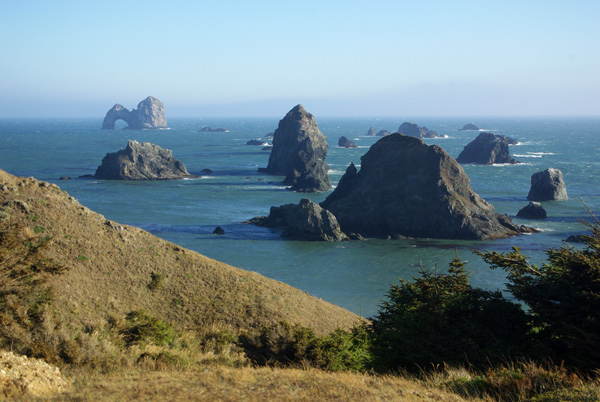
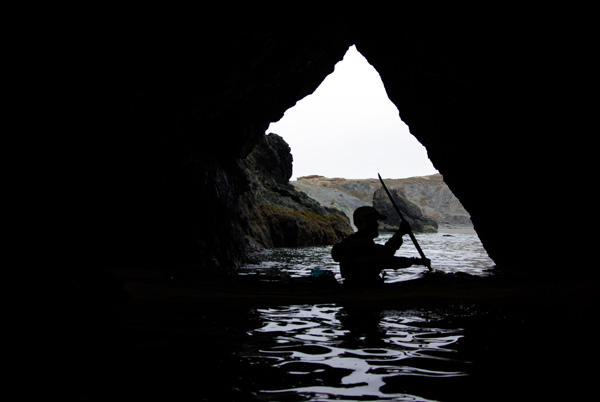
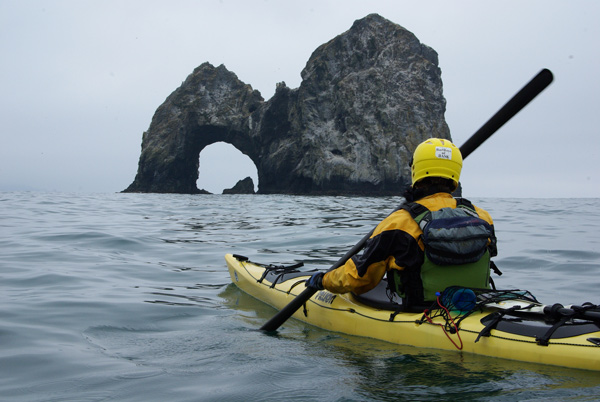
I woke early under grey, but dry skies, still fascinated by the difference in moisture between here and the north coast. The redwood coast is dripping wet, and so is everything north of Port Orford, what made this place so much drier? I dressed quickly and launched, eager to explore the extensive reef that surrounded the point. I found Mike bobbing happily is a sea cave scoured beneath the offshore island and we paddled in and out of the multiple entrances. The swell had dropped to nearly nothing and the air had the 'feel' of a windless day to come, we couldn't believe our luck! Every little slot, arch, and cave would be open for business. Dave showed up eventually, and we all headed southwest, paddling through the giant Mack Arch, an obligatory passage but one that I regarded as boring compared to the more intimate tunnels near shore. On the three mile crossing back to the shoreline I confided in Mike, "Don't take this the wrong way but I still haven't seen anything better than Cape Falcon." my beloved coastline three hundred miles north of here. We were, however, paddling toward what the chart showed to be a heavily indented and steep section of coast. Lured by hope of narrow passages we traced the shoreline through tunnels and arches that didn't disappoint. Every hundred yards the passages squeezed tighter, and we drew deep into the labyrinth as though led by a siren's song. Caves opened into other caves, and led us to a series of walled in coves, each of which could become a prison with even a small increase in the swell. We took a chance landing and setting up camp in a hidden cove but all of us felt that the risk was worth the sublime location. Our beach ended about fourteen inches above the high tide line and a worst-case scenario would see us cowering on the rugged slope behind camp. Unpleasant, but survivable.
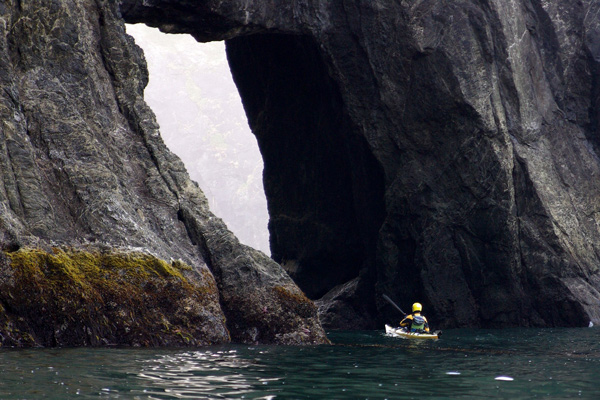
Lounging on the beach I washed down peanut butter and raspberry jam and then zipped up my dry suit for a little more exploring. Holding onto the bow, I swam my kayak into the middle of the cove, taking a moment to just float in my gear befor crawling aboard. I delighted in the maneuverability of the now unladen skin-kayak. Like paddling a feather I dipped the paddle and the kayak answered without the sensation of inertia that accompanies a heavier hull. I swept, carved, and disappeared through a cave that led to the outside. Inside the passage I was suspended in pool of bright green water illuminated by the sun pouring in underwater. Dave soon joined me, and twenty minutes later Mike appeared and we all took a second tour of the three mile long drowned labyrinth.
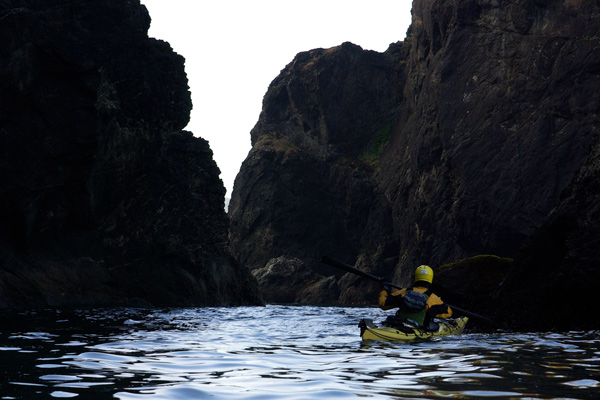
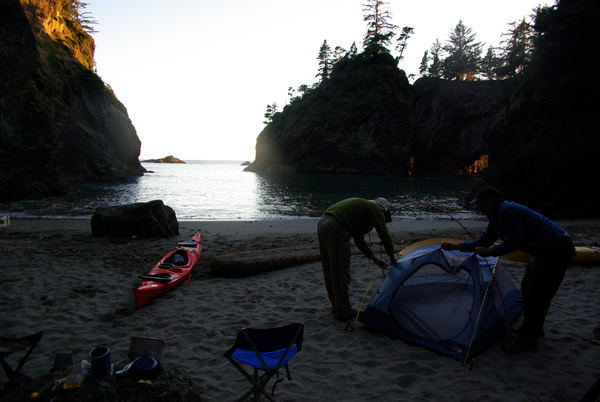
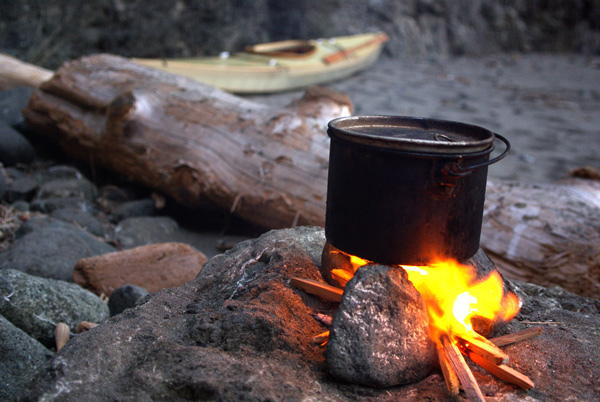
For hours that afternoon I poked about lazily, nosing into the nooks along the shoreline. I drifted aimlessly letting the light winds and swirling currents choose my route, only pushing away from rocks when I had to, lying on my back deck and letting the world spin in slow circles. Prehistoric looking pelicans soared above in carefully ordered squadrons, a family of river otters swam by. On the cliff adjacent to the entrance to our cove, a single fir tree cast a shadow so perfect that it appeared to be painted on the rock. Perfection, I thought. I dragged the kayak up the beach speculating that I'd probably paddled twenty miles but traveled only six. I corrected my earlier statement. "Gentlemen, this is definitely better than Cape Falcon."
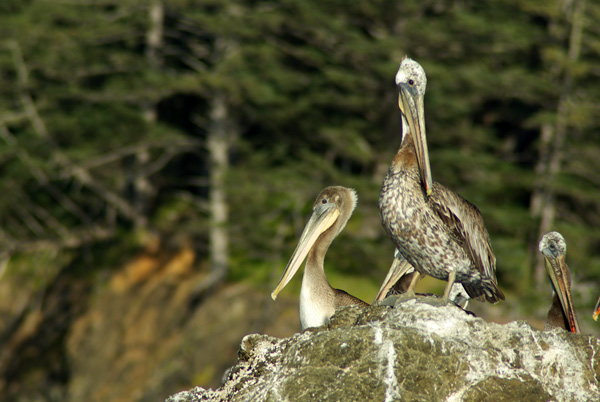
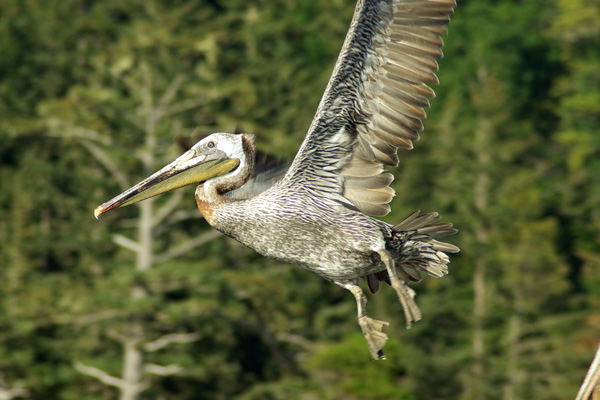
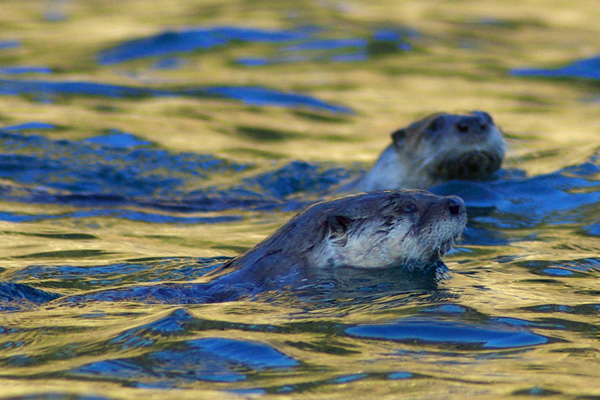
Paddling at sunrise past a mile long stretch of cliff lined beaches, I yawned as mixed fog and sunshine poured through the trees illuminating everything with defined, crisp, beams. To me it felt like we were kayaking in the setting of a Jehovahs' witness pamphlet, the kind with pictures where God is depicted in glowing rays.
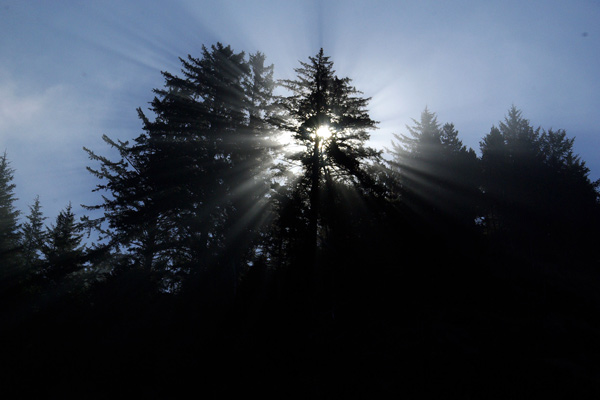
I was worried we'd seen the last of the caves, when we rounded a corner to find another deeply carved section of cliffs, this one more exposed with a stronger surge. I played on the fingers that jutted into the open ocean letting the sucking whitewater pull me in and taking great swooping elevator rides up the sharp encrusted rocks. Mike probed an unlikely slot and raised his paddle vertically, indicating that there was an outlet and we followed him, paddling behind a rock the size of a house to discover a large cave led back to the sea. I followed Mike under the arch to see him suddenly change direction and disappear into the wall. There was a cave in the cave and it formed a long narrow corridor that also opened to the outside. "Stop!", I yelled, "Let's wait and see what the next set does, I don't want to get crushed in there." When a cave closes out the total volume of a kayak equals it' weight in water plus the momentum of the surge. A thousand pounds of weight with a bit of a shove behind it is a lot of force and people have been killed when their spines broke across jagged roofs. It's always worth a reminder because it only takes one overzealous decision to send you kayaking into the great beyond. This cave had a high ceiling and no visible undercuts or cross currents, so we gave it the green light and Mike paddled through followed by me, and Dave. We were delighted to find a waterfall at the exit!
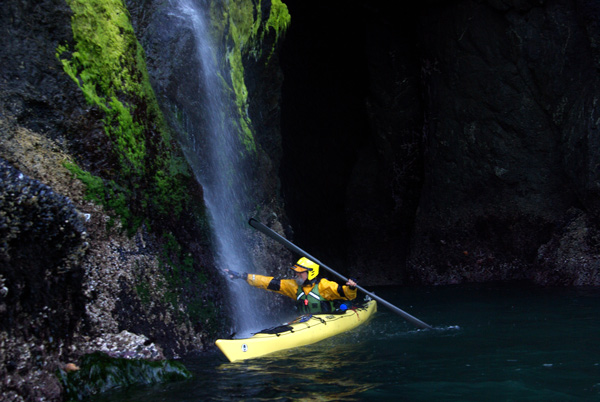
On the other end the sun beamed in brightly and we beamed even brighter, it was like someone had given us an extra day of Christmas and we discovered a dozen more exciting passages before the coastline opened up again into a field of rocks. For fun we threaded marginal passages in the very low swell, occasionally getting stuck in the rocks. "Thank god there are no more caves," I said, "it's taken us two days to go ten miles!" Mike explains to me that mathematically the length of coastlines closely follow a fractal curve, that is, they get longer the closer you follow them, usually in a predictable manner that could be plotted as a spiral on paper. I pondered the Zen in this statement; it's implications for discovering richness and detail by going slower and more carefully. I contrasted it against the bold sense of achievement one gets from hammering out thirty-mile days and the closeness one gains with the sea during those long passages. Like most kayakers, Mike is an explorer of the edge, the intimate zone where the moody pacific beats the continent into submission, one grain at a time. He kayaks for the best of reasons, to see what's out there.
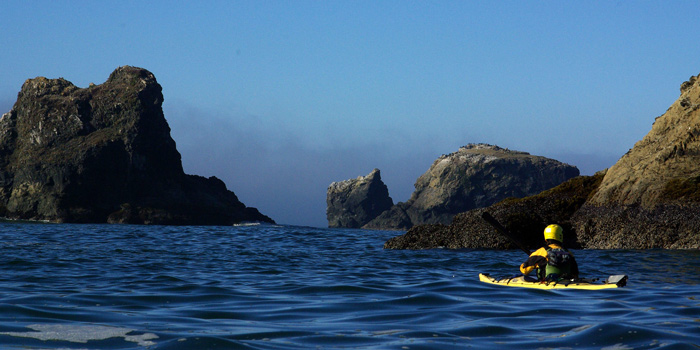
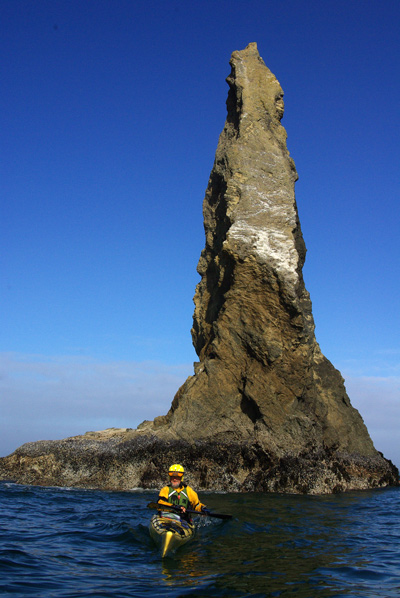
Nearing the end of our journey I spotted one final crack in a monolith that stood out from the rocky shoreline, now crawling with beachcombers as we neared the city of Brookings. The slot was eight feet wide and it's smooth basalt walls rifled sixty-feet up on either side. I could see light at the other end but I couldn't tell what was back there. "What the heck." I said, I surfed through and popped out the other side into the middle of a thirty-foot wide tidepool. More than a dozen small children and their parents stopped poking at sea creatures and looked up at me simultaneously. Startled, we blinked at each other and their tiny minds registered for the first time a new possibility in life. I swung the bow around and surfed back out through the slot. "What's in there?" Mike asked. "Oh, it's just a tidepool, it doesn't go anywhere.", I replied, concealing my discovery of precious treasure.
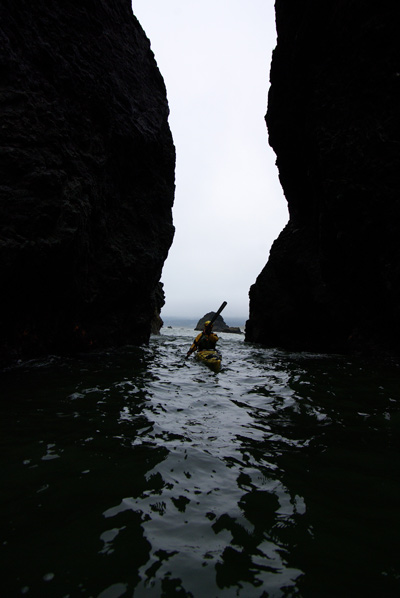
Landing at the dock I congratulated Mike on his achievement, and in my usual impetuous manner I just wanted to sprint to the car, grab a burger, and speed home. I tried to imagine it from Mike's point of view, but from what I could tell, this was no grand feat, but simply another leg in a the journey the just happened to correspond with the end of the thirteen hundred mile coastline. I have no doubt that Mike will extend his quest to include the entire coast of Baja, of which he has already completed large sections, and I wouldn't be surprised at all to find him in his seventies, linking the coastlines of Canada and Alaska. Perhaps I'll visit, swooping in to pick off the good sections, and perhaps I will eventually discover the best brand of macaroni and cheese.
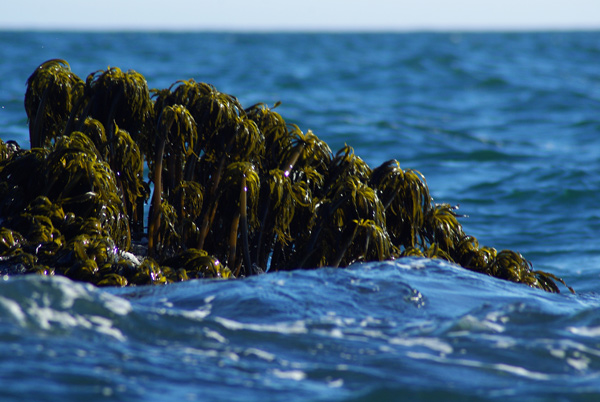
Back to Cape Falcon Kayak